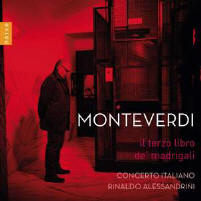Texte paru dans: / Appeared in: |
|
|
Outil de traduction ~ (Très approximatif) |
|
|
Reviewer: Catherine
Moore
When Claudio Monteverdi
(1567-1643) wrote about performing madrigals he stressed the importance of
text expression, and this ensemble takes that to heart. Illuminating each of
Monteverdi’s expressive gestures is not easy to do in Book 3 (published
1592) where the composer has packed gestures together, piling them on top of
each other. In some madrigals, such as ‘Rimanti In Pace’ there’s a certain
Gesualdo quality in the dense texture. Director and ensemble founder Rinaldo
Alessandrini describes his interpretive approach: “Monteverdi urges us to
let the text live almost word by word, demanding a microscopic mcroscopic
identification with what the text itself allows us to glimpse behind it. And
this is not merely and exclusively a question of correct pronunciation, but
the ability to ‘simulate’ in theatrical terms a truth that exists in the
abundant, proliferative stage of the human soul.” As a listener, it’s
important here to take the time to savor and repeat. I found it rewarding to
listen alternately with and without the words in front of me.
Book 3 is generally regarded
as the collection where Monteverdi increasingly used the dramatic
techniques—such as declamato and concitato—that he developed through the
later books. For example, in ‘Vattene Pur, Crudel’ (text by Tasso) we get a
taste of the composer’s skills in depicting a battlefield’s desolate
landscape, peopled by combatants faint with war and abandoned. The drama,
suspense, and vivid evocation of place found in this madrigal are used in
expanded form in Monteverdi’s great battle narrative ‘Il Combattimento di
Tancredi e Clorinda’ (Book 8, also Tasso). Concerto Italiano’s mastery of the style is complete: ensemble blend, ebb and flow of phrasing and tempo, vocal gesture, and color are used in countless ways. For instance, in ‘Stracciami Pur Il Core’ sharp edges on the vocal attack for the opening declaration “Rend my heart asunder, then!” are fittingly serrated, and a subtle open-throated warble in ‘O Rossignuol, Ch’in Queste Verdi Fronde’ evokes the titular nightingale. These are very fine interpretations. Keeping up momentum while conveying the meaning of each word is hard to do, and sometimes (such as in ‘Rimanti In Pace’) it feels as though the overabundance of puzzle pieces or textured threads in a wall hanging—some bulky, some slender—drape rather heavily on the singers. Even a small amount of leavening would generate more forward movement and animate the flow.
John Barker
praised this ensemble’s reissued 1992 recording of Book 6 (Arcana 425, M/J
2017) and also their more recent “wonderful array of ‘great Monteverdi
moments’” in a program of madrigals and sinfonias called Night (Naive 30566,
N/D 2017). | |
|
|
|
|
Cliquez l'un ou l'autre
bouton pour découvrir bien d'autres critiques de CD |
|




